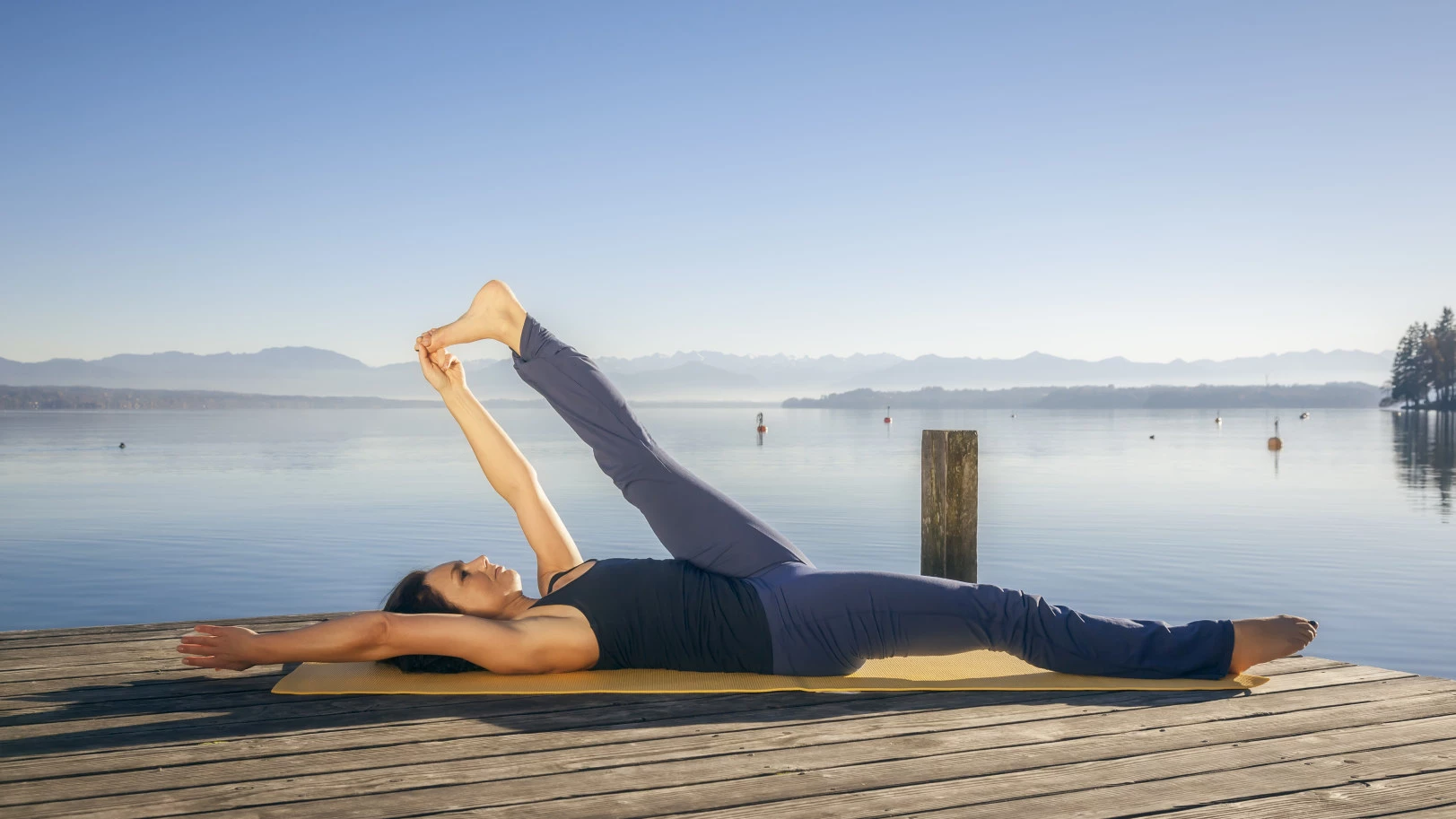Take Your Practice Deeper: Stretching and Muscle Engagement in Yoga Practice

Yoga is more than stretching. The definition of yoga is, in one word, is unity (of body, mind, and spirit). Without discounting mind and spirit, understanding the physical aspect of yoga will enhance the overall experience of unity.
As you explore your body’s abilities on the yoga mat, you will undoubtedly experience the sensation of stretch. Stretching has many benefits, including improved circulation, joint mobility, and muscle elasticity.
But did you know that there are many ways to approach stretching in your yoga practice? Here are a few ways to vary it up.
Understanding Stretching and Muscle Engagement in Yoga Practice
When practicing yoga, we engage in various forms of stretching and muscle activation, each serving distinct purposes in developing flexibility, strength, and body awareness. Understanding these different approaches can help create a more effective and safe practice.
Types of Stretching
Static stretching, perhaps the most familiar form in yoga, involves holding a pose in a fixed position for an extended period, typically 30-60 seconds. You’ll experience this in poses like Seated Forward Fold (Paschimottanasana), where you maintain a gentle stretch in the hamstrings, or in Pigeon Pose, where you sustain a hip-opening position. This type of stretching is particularly effective for increasing overall flexibility when practiced regularly.
Dynamic stretching introduces movement into the practice, flowing through poses rather than holding them. The Cat-Cow sequence exemplifies this approach, as does the flowing movement of Sun Salutations. Dynamic stretching helps warm up the body, increases circulation, and prepares muscles and joints for deeper work.
In active stretching, you use your own muscle strength to maintain a stretch without external support. Good examples are standing poses like Warrior III or Standing Split, where muscle engagement helps maintain balance and alignment. This approach builds both strength and flexibility simultaneously.
Passive stretching, in contrast, relies on external forces such as gravity, props, or assistance to deepen a stretch. This method is particularly valuable in restorative yoga, where props like bolsters and blocks support the body in gentle, sustained stretches. A supported Bridge Pose with a block or a restorative Forward Fold with bolsters exemplifies this approach.
PNF (Proprioceptive Neuromuscular Facilitation) stretching alternates between muscle contraction and relaxation. In yoga, you might experience this when using a strap in Supine Hand-to-Big-Toe Pose, first engaging against the strap’s resistance, then relaxing to move deeper into the stretch.
Types of Muscle Contractions
Understanding the different types of muscle contractions you can do in a stretch adds another layer to our yoga practice.
Isometric contractions occur when muscles engage without changing length – think of holding Plank Pose, where your core and arm muscles work steadily without movement. These contractions build strength and stability, particularly beneficial for those with osteoporosis as they help maintain bone density.
Concentric contractions involve muscles shortening as they contract – you experience this when rising from Chair Pose to Mountain Pose, as your quadriceps contract and shorten. These movements build functional strength and power.
Eccentric contractions occur when muscles lengthen while under tension – like slowly lowering into Chaturanga from Plank Pose. This type of contraction often creates the most muscle soreness but is crucial for building strength and control.
Isotonic contractions combine both concentric and eccentric movements, as seen in flowing sequences like Sun Salutations, where muscles continuously shift between shortening and lengthening under control.
Why the Type of Stretching Matters in Yoga
When practicing yoga, it is important to move with control and to stay tuned to the sensations of the body. “No pain, no gain” is NOT a mantra of yoga. When doing static or passive stretching, it is useful to consider that we may be compressing a joint or straining a ligament, which is usually accompanied by an unpleasant sensation. This is not generally a goal unless there is a therapeutic reason for doing so and you know what you are doing and why.
More often, a pleasant sensation of stretch in the center of a muscle is desired and therapeutic. This may seem obvious, but many people may feel that getting through the unpleasantness is part of the process. Perhaps this is true in rare cases, but for the most part, pain is a sign to back off.
How Hard Should I Push Myself in Yoga Poses?

It is generally not recommended to stretch a muscle at its tendon (its insertion point on a bone) or to stretch a ligament. This may happen if you push too hard, have weakness in a muscle, and/or lack the strength to control joint movement. Stretching a tendon doesn’t feel very good. If you find that certain poses result in discomfort despite your efforts to control the motion, you may need to work on muscle strength or modify until the sensation is less intense. Improving your body awareness and understanding your body’s limitations will help you determine when it’s safe to push, and when it’s smarter to yield.
Why am I so….Inflexible?
Limitations in flexibility are due to more than just muscle tightness and include joint structure, ligaments, tendons, neural mobility, and genetics1. In fact, stretching does not necessarily lengthen muscle fibers. Improved flexibility and range of motion in joints are due to increased stretch tolerance rather than increased muscle length.
The word “tolerance” in this context means adaptation. To tolerate also means to accept and endure. Through practice, repetition, and technique, we learn to let go (rather than accept and endure), which creates a shift in not only our physiology but perhaps also in the psyche. Flexibility is defined as the range of motion in your joints, but also as the ability to bend without breaking or willingness to compromise. To consider these polysemous words in the bigger context of yoga, we start to understand that practicing yoga embodies more than the physical.
Staying Safe in Yoga
The safest way to apply the principle of strength with flexibility is to stretch with the muscle around the joint while toned (in an active state). An example of this would be in Dhanurasana (Bow Pose). When you are on your belly grasping ankles, you press the ankles into the hands to use the quadriceps (agonist) while you are stretching them. Likewise, in Padangustasana (Hand-to-Foot Pose, mimicking a hamstring stretch), you activate the quadriceps (antagonist) to reciprocally relax the hamstrings. Actively moving into a pose and then gently contracting either the muscle(s) being stretched or the opposing muscles is the safest method of stretching. Passive stretching may be more intense, but is intensity necessary or safe?
Finding Balance
Hatha yoga should be a balance between strength, flexibility, and relaxation. An overly flexible muscle that has little strength may not function properly in everyday life. Similarly, a very stiff muscle or joint may be unable to function properly. If we gently activate muscles while in stretching positions, we protect the joints, and we learn to respect our limitations and vulnerabilities at any given moment. The balance of wanting to go further and knowing when to stop is experienced, as is the understanding of what yoga is truly about. Now, that is practicing smart, safe yoga!
Also, read...
The Yoga Sutras: Practicing Non-Attachment without Becoming Detached
The Broomstick Effect: The #1 Key to Perfecting Balancing Yoga Postures
Related courses
Breath as Medicine: Yogic Breathing for Vital Aging
Yoga and Myofascial Release: Releasing Chronic Tension with the Bodymind Ballwork Method

Christine Carr, c-IAYT, eRYT 500 has been a physical therapist for over 20 years. In her youth, she was constantly hurting herself. This motivated her to learn how to recover from injury and heal herself, naturally. She loves to learn. Studying the human body, and mind and how they function together is exciting to her. She has a diverse academic background with experience that includes orthopedics, yoga, and functional medicine. She enjoys teaching others how to recover from injury, manage their condition, and improve their function and performance.
Christine enjoys any and all sports available in this beautiful area or kicking back with a good book in her spare time. She has recently started gardening, though she said she has much to learn!



